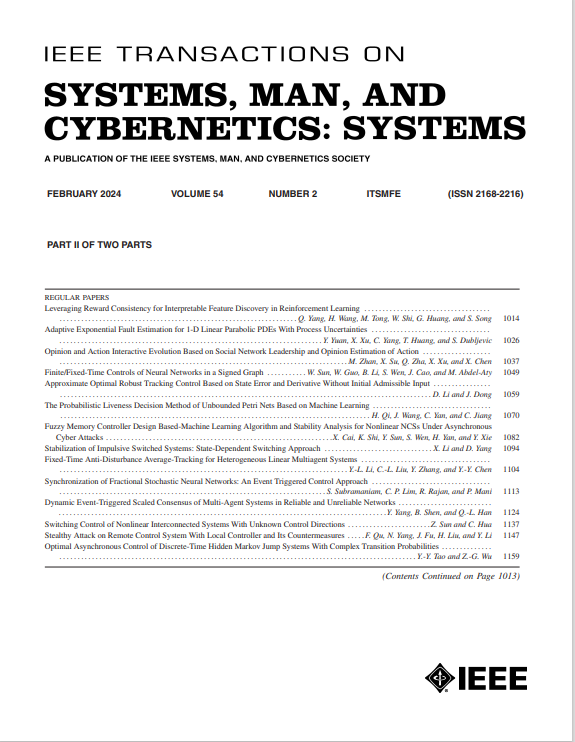基于隶属函数迭代学习的模糊系统有限频率优化故障检测
IF 8.6
1区 计算机科学
Q1 AUTOMATION & CONTROL SYSTEMS
IEEE Transactions on Systems Man Cybernetics-Systems
Pub Date : 2024-12-03
DOI:10.1109/TSMC.2024.3498906
引用次数: 0
摘要
本文提出了Takagi-Sugeno (T-S)模糊系统的有限频率优化故障检测策略。在不完全前提匹配(IPM)策略下,首次提出了一种具有$L_{\infty }/L_{2}$鲁棒性能和有限频率$ H_{-}$故障敏感性能的加权模糊FD观测器(WFFDO),表明残差信号对外部干扰具有鲁棒性,对潜在故障敏感。引入了一些参数和松弛矩阵,得到了设计混合性能WFFDO的较为宽松的条件。随后,为了实时更新观测器的隶属函数,本文提出了一种新的指数衰减学习率的在线隶属函数迭代学习算法,使观测器的隶属函数达到最优$L_{\infty }/L_{2}$性能。此外,利用Lyapunov稳定性理论,建立了保证结构化均方误差代价函数收敛的充分判据。最后给出了两个仿真实例,说明了所开发的优化FD技术的可行性和优越性。本文章由计算机程序翻译,如有差异,请以英文原文为准。
A Novel Finite-Frequency Optimization Fault Detection for Fuzzy Systems by Membership Functions Iterative Learning
This article presents the finite-frequency optimization fault detection (FD) strategy for Takagi-Sugeno (T-S) fuzzy systems. Under the imperfect premise matching (IPM) policy, a weighted fuzzy FD observer (WFFDO) with the $L_{\infty }/L_{2}$ robustness performance and the finite-frequency $ H_{-}$ fault sensitivity performance is first proposed, which signifies the residual signal is robust to the external interference and sensitive to potential faults. Some parameters and slack matrices are introduced to obtain more relaxed conditions of designing the WFFDO with mixed performance. Afterward, a new online membership functions (MFs) iterative learning algorithm with the exponential decay learning rate is proposed for the sake of updating the observer MFs in real-time such that optimal $L_{\infty }/L_{2}$ performance can be achieved in this article. In addition, sufficient criterion is established so as to ensure the convergence of the structured mean squared error cost function by means of Lyapunov stability theory. Eventually, two simulation examples are given for illustrating the feasibility and superiority of the developed optimization FD technique.
求助全文
通过发布文献求助,成功后即可免费获取论文全文。
去求助
来源期刊

IEEE Transactions on Systems Man Cybernetics-Systems
AUTOMATION & CONTROL SYSTEMS-COMPUTER SCIENCE, CYBERNETICS
CiteScore
18.50
自引率
11.50%
发文量
812
审稿时长
6 months
期刊介绍:
The IEEE Transactions on Systems, Man, and Cybernetics: Systems encompasses the fields of systems engineering, covering issue formulation, analysis, and modeling throughout the systems engineering lifecycle phases. It addresses decision-making, issue interpretation, systems management, processes, and various methods such as optimization, modeling, and simulation in the development and deployment of large systems.
 求助内容:
求助内容: 应助结果提醒方式:
应助结果提醒方式:


